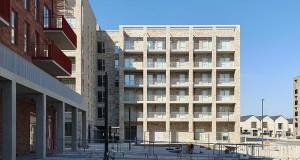
- Government
- Posted
Dublin district to lead the world on energy efficiency
Passive House Plus analyses Dún Laoghaire-Rathdown County Council's plan to make the passive house standard mandatory for all new buildings in the district.
As has been widely reported, Dublin-based local authority Dún Laoghaire-Rathdown County Council has voted to make the passive house standard mandatory for all new buildings in the area as part of its latest development plan.
At a meeting of the local authority on Wednesday, 11 February, councillors voted by 23 votes to 14 to add wording to the 2016-2022 local development plan stating it is, “Council policy that all development in new buildings should be built to the Passive House standard.”
The motion also stated that nearly zero energy buildings (NZEBs) or other lower energy standards may be considered as appropriate alternatives.
The Passive House Association of Ireland together with Passive House Plus, which has its own office based in the area, organised a trip for councillors to Niall and Monica Walsh’s passive house in Mount Merrion in advance of the vote, during which presentations on the passive house concept and its benefits were made. The 256 squre metre house, which is profiled in the new issue of the magazine, has cost less than €200 per year for combined space heating and hot water since the family of four moved in.
The draft development plan will now enter a public consultation period that will begin on 2 March and last for ten weeks. Dún Laoghaire-Rathdown County Council has a history of demanding higher energy efficiency standards than national regulations. It was one of the first local authorities, back in 2007, to demand that buildings be constructed to more stringent energy efficiency standards than national regulations, passing 40% energy and carbon reduction targets, along with mandatory renewable energy systems.
Local authorities in Ireland can set energy efficiency standards above levels in building regulations as a planning condition, something which is not possible in England after the Conservative-Liberal Democrat coalition removed a clause in the Planning Act that permitted councils to set their own energy efficiency standards above those contained in building regulations.
The Construction Industry Federation has come out in opposition to Dún Laoghaire-Rathdown plan, claiming it would lead to an increase in the cost of new build in the area.
But writing in the new issue of Passive House Plus, editor and publisher Jeff Colley disputed this idea: “As I explained in an Irish Times article, one of the reasons why this policy won’t cause price increases is that anyone building a new home in Ireland has to achieve 60% energy reductions and install a renewable energy system to meet prima facie compliance with building regulations anyway. That’s thanks to changes to Part L of the Building Regulations that this magazine’s predecessor Construct Ireland helped to bring about from 2008 to 2011 – changes which in turn emerged from initiatives we worked on with Fingal, Wicklow, Dublin City and, yes, Dún Laoghaire-Rathdown County Councils in 2005 and 2006.”
“The fact is that compliance with Part L typically means an A2 or A3 BER [building energy rating], bringing construction costs up to passive house levels, but with no guarantee that the building will actually work. Dún Laoghaire-Rathdown deserve great credit for committing to a building standard that actually works – a standard that’s firmly rooted in building science.”
Colley also pointed out that the CIF has been objecting to better building standards for decades, based on the cost argument. “The Construction Industry Federation has immediately assumed a defensive posture, arguing in the same Irish Times article that the draft policy would cause construction prices to increase, and that if the policy goes ahead ‘there will be very few houses built in Dún Laoghaire-Rathdown next year’. The CIF raised similar objections as long ago as 1978, when it argued against proposals to make insulation mandatory for new homes on the spurious basis that it would cause house prices to rise.”
“I invite the CIF to tap into the expertise that has accumulated on passive house in Ireland, and speak from an informed position. No builder or subcontractor who’s committed to quality has anything to fear from passive house.”
If the passive house clause makes it into the final version of the development plan, Dún Laoghaire-Rathdown County Council would become the first local authority in the world outside of continental Europe to make the passive house standard mandatory.
Colley continued: “There is a pressing need to adopt passive house without delay, as some of the approaches the construction industry is taking to meet new building regulations will fail to deliver anticipated energy savings, while compromising indoor air quality and leading to the need for repair work.”
“Passive houses work. We have the benefit of 25 years of detailed monitoring to show that these buildings are genuinely energy efficient, healthy, comfortable and built to last. So the construction industry has nothing to fear from passive house and much to gain. Dún Laoghaire-Rathdown have shown great vision and leadership in backing an approach that delivers demonstrably high quality sustainable buildings. Once the industry stops blindly objecting, and instead engages and starts working out how to deliver this cost-effective quality standard, it won’t look back. “








